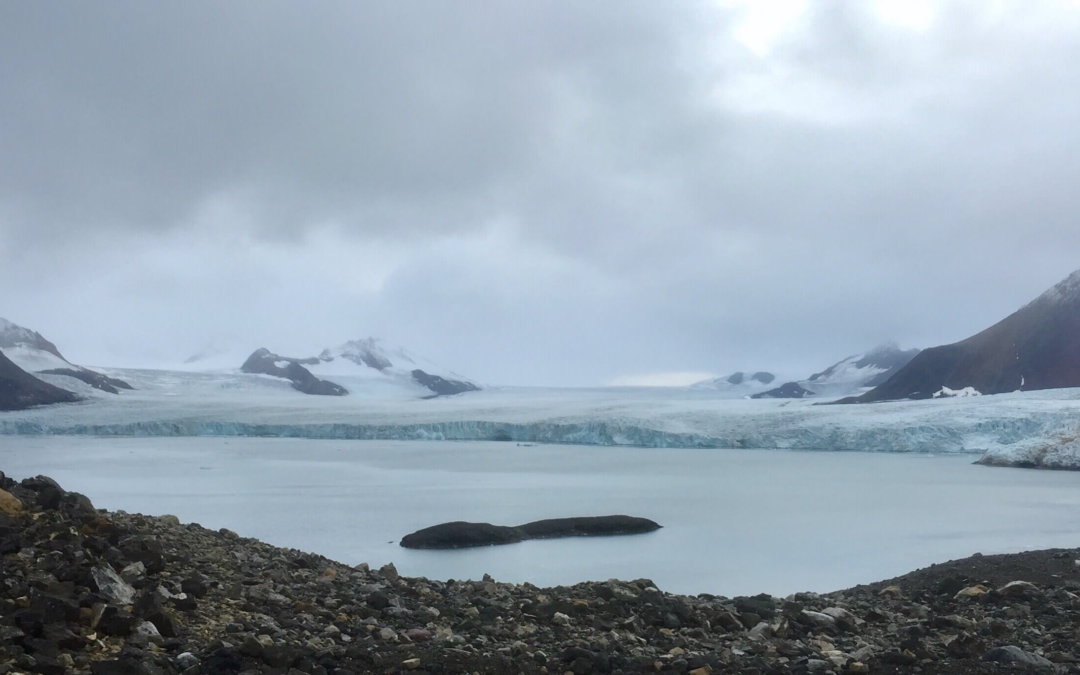October is mating month for the Svalbard Reindeer and our sightings have been absolutely phenomenal. The strong bulls can defend a harem of more than 10 cows. They are not shy at all and have no predators so perhaps it was not a strange encounter when a large male bull/buck walked continuously towards us. Ettra, who is just over 2 and a true Polar dog has her senses on overdrive with all of the newness here around Bamsebu. She went ballistic – tugging at Hilde’s waist belt – when the buck approached and then sat calmly as it took step after step until it came to within 2 metres. Then it turned on a dime and ran off.
Just 2 days ago we had 21 reindeer to the north and south of Bamsebu – directly outside. We could hear them breathing, the buck snorting to call his harem closer. To be observers to moments like this are full of deep sighs of gratitude. The Svalbard reindeer are endemic to Svalbard and they number around 19,000 total and while they travel alone or in small groups anything over 20 in one sighting is quite special.
Getting used to daily life
October is also when we will lose our days to the long Polar Night. This happens on October 26th when the sun will dip below the horizon until Feb 16th. Needless to say we have put our sunglasses away and have our Vitamin D ready. This short time of transition puts us in overdrive to make sure we have everything we need tightly stacked close by. Wood, water, clothing, food.
We are both master space savers and have limited storage ability here at Bamsebu so we need to make sure we utilize all shelter properly for our canned & packaged goods, root vegetables, eggs and anything in glass. We have Insulated the Outside Shed and sorted through what we need to store inside and in the shed where things can freeze. We also have polar bear proof barrels outside for our food resupply. Our 1000 litre water tank is already frozen outside so bringing in small containers of water that can thaw is a daily task. It takes so much time to simply survive, stay warm, prepare food and do tasks. We have our fire extinguisher installed inside along with a carbon monozide and fire detector. Safety in all respects is key!
Data collection is on it’s way
We have collected insects for UNIS, recorded wildlife sightings for Norsk PolarInstitutt, collected salt water and phytoplankton samples for Scripps Institution of Oceanography and taken a timed flight using Indro’s thermal imaging drone. The additional element of thermal imagery captured by the drone will help to answer questions regarding any relationship between water surface temperature and phytoplankton concentrations with respect to the introduction of freshwater from melting glaciers into the marine environment.
Interactive school classes – get your local school to join!
October’s theme for the monthly schools call is : Climate Change and we are thrilled to have Kim Holmen, International Director for the Norsk Polarinstitutt as our leading expert –please help us to spread the word to schools around the world. You can share the link here for schools to sign up- there is no charge. Our intention is simple- to engage and broaden the dialogue so we all feel more empowered and knowledgeable around pressing concerns and issues our planet faces. Our first school call in September around Ocean plastics went well though we were a bit challenged to share video we called in with voice and shared a short video clip in advance. All of these challenges with technology are a reminder of our remoteness and how we are standing on the front lines of testing equipment and satellite connectivity. We are the first non-commercial or non-military entity to receive Ground Control’s new MCD Mission Link, which is pretty cool!
We are now three weeks in and are enjoying every passing minute. Every day is active and full of challenges that are new and require patience, creativity and a solution. Our days are 17 hours long. We’ll share more details on our days in the next blog.
xoxo Sunniva and Hilde


Incredible! October 26th will be a very interesting time moving forward! We tend to thrive on sunlight, the challenge will be formidable as you push through the winter season! Yet having prepared for that, no doubt, you guys have the means, the knowledge and the tasks to deal with that better or as good as anyone!! Virtual warm hugs sent your way! ?
‘Button up your overcoat’ and thanks for the update!
Thank you for the updates! I love following along!
Thank you for your blog. If you want to contact schools, would Greta Thunberg be a good resource?
Most definitively! We’ve tried to get in touch with her actually, but haven’t succeded. Do you happen to have her #??
Hun er både på FB og Insta under sitt navn gretathunbet
Hi, Sandy and Diana from Indiana who went on the Olivia Antarctica cruise. So excited about your project. Will be following your work throughout the winter. Great adventures to you!
Ladies, you rock! I can only imagine the sheer silence of the place (except for the breathing and snorting of reindeer). Such an honour to know you both. xo Deb
Hello to you three!
LOVE to read your blogs! I feel so proud to see a canadian woman be part of an exceptional duo in this exciting journey. Keep up the good… and hard… work. Hope you take breaks! We are rooting for you!?
Cheers!
Wonderful to read your blog. Hanging on every word. I’m guessing most readers are intensely interested in everything you do, from daily chores and meal prep, to outdoor sightings and observances, to scientific experiments. Also, mental and emotional challenges of living in such tight quarters…those may come later. Thanks for your updates!
Thinking of you all and tomorrow!